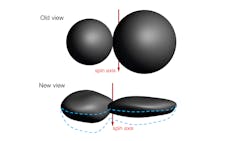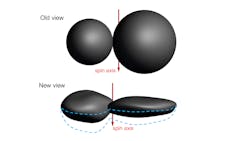New photos show Ultima Thule is more pancake-peanut than snowman
Back on Jan. 1 of this year, the Long-Range Reconnaissance Imager (LORRI) aboard NASA's New Horizons spacecraft snapped photos of the most distant object ever explored—a Kuiper Belt object nicknamed Ultima Thule.
Photographed from 18,000 miles (28,000 km) on approach, the initial images showed what appeared to be a snowman-shaped object of two connected spheres, measuring 19 miles in length. The peculiar shape was endeared by the space community.
However, newer images downloaded from the LORRI—showing New Horizon's departing view of Ultima Thule during the spacecraft's flyby show the more detail than those seen on Jan. 1, and reveal the object isn't so snowman-like after all.
Seen in the Tweet and image below from John Hopkins University's Applied Physics Laboratory, stringing together 14 images from New Horizon's approach and departure views of Ultima Thule (officially named 2014 MU69) into a short movie show the object's two sections aren't spherical. The larger lobe (Ultima) looks more like a giant pancake, while the smaller lobe (Thule) has a dented walnut shape.
"The first close-up images of Ultima Thule—with its two distinct and, apparently, spherical segments—had observers calling it a "snowman." However, more analysis of approach images and these new departure images have changed that view, in part by revealing an outline of the portion of the KBO that was not illuminated by the Sun, but could be "traced out" as it blocked the view to background stars," mission principal investigator Alan Stearn of Southwest Research Institute said in a news release by John Hopkinis APL on Feb. 8. "We had an impression of Ultima Thule based on the limited number of images returned in the days around the flyby, but seeing more data has significantly changed our view. It would be closer to reality to say Ultima Thule's shape is flatter, like a pancake. But more importantly, the new images are creating scientific puzzles about how such an object could even be formed. We've never seen something like this orbiting the Sun."
About the Author


